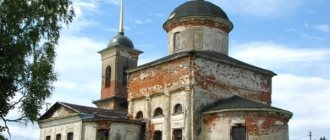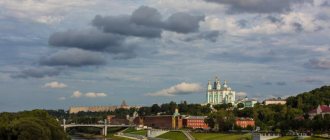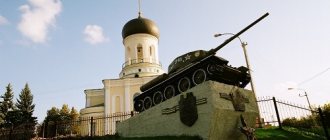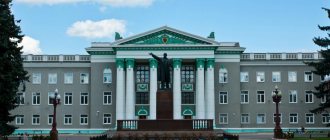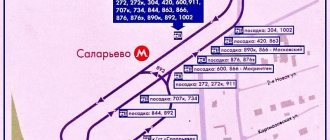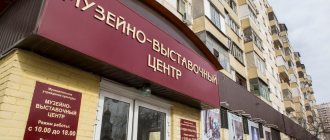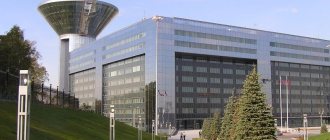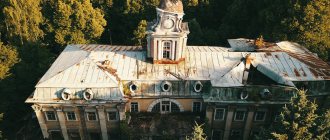Content
- 1 Epiphany Church (Vereya)
- 2 Ascension Church (Burtsevo)
- 3 Temple of the Entrance to Jerusalem (Vereya)
- 4 Demetrius-Thessaloniki Temple (Dubrovo)
- 5 Elias Church (Aprelevka)
- 6 Elijah Temple (Vereya)
- 7 St. John the Baptist Church (Afineevo)
- 8 Church of Constantine and Helena (Vereya)
- 9 St. Nicholas Cathedral (Naro-Fominsk)
- 10 St. Nicholas Church (Ateptsevo)
- 11 St. Nicholas Church (Kamenskoye)
- 12 Church of the Intercession (Petrovskoe)
- 13 Church of the Intercession (Tashirovo)
- 14 Church of the Transfiguration of the Lord (Spas-Kositsy)
- 15 Transfiguration Church (Slepushkino)
- 16 Seraphim Temple (Selyatino)
- 17 St. Sergius Church (Mogutovo)
- 18 Trinity Church (Martemyanovo)
Economy and industry of Naro-Fominsk
The basis of the revenue side of the city budget is industry. There are 25 large enterprises operating in Naro-Fominsk.
- Keralit produces products from refractory materials.
- “Ball Beverage Packaging Naro-Fominsk” produces aluminum cans.
- “Salyut” is the production of parts for aircraft jet engines.
- “Naro-Fominsk Plastics Plant” produces plastic products for cultural and domestic needs.
- The Naro-Fominsky mother plant is an organizer and producer of regional nutrition in educational institutions.
Epiphany Church (Vereya)[edit]
Epiphany Church
built in 1777 at the expense of the Verei merchant M.E. Sedelnikov in the Baroque style, on the site of a dismantled wooden church. In 1782, a brick bell tower was added to the temple.
The temple is an example of church architecture of the last quarter of the 18th century. In 1967-1969, under the leadership of the architect-restorer N.N. Sveshnikov, restoration work was carried out, in 2007 the temple was updated and landscaped.
In the 1930s, Alexy Serebrennikov served as a psalm-reader in the church; in 1937, he was arrested and executed by the NKVD troika. He was buried in an unknown common grave at the Butovo training ground near Moscow, and is now glorified as one of the holy new martyrs.
Address:
Moscow region, Naro-Fominsk district, Vereya city, st. January 19, no. 2.
Church of the Ascension (Burtsevo)[edit]
Ascension Church
built in 1730 by the owner of the village M.S. Anichkov, on the site of a dilapidated wooden Tikhvin church, built in the early 18th century.
The two-story brick building of the temple has a unique composition, in which the arms of the cross are equal in height to the central volume, the technique of arranging small chapters in the cardinal directions, and the extreme laconicism of the decorative decoration develop the artistic principles inherent in the architecture of the Great Cathedral of the Donskoy Monastery in Moscow. In 1788, the temple was repaired, adding a third tier of bell tower with a spire.
Address:
Moscow region, Naro-Fominsk district, Burtsevo village, 120.
Telephone:
+7 (496)342-70-74
Naro-Fominsk district is located in the southwest of the Moscow region. It borders with the Podolsk region (in the southeast), Odintsovo and Ruzsky districts (in the north), Mozhaisk (in the northwest) and with the Kaluga region (in the southwest). Length (from northeast to southwest) - 110 km. Number of settlements - 295. Cities and urban settlements - Naro-Fominsk (57 thousand people), Aprelevka (19.7 thousand people), Vereya (5 thousand people), Alabino, Kievsky, Kokoshkino. The number of rural districts is 13. In total, there are 310 settlements in the district. The administrative center is the city of Naro-Fominsk .
The area of the district is 1929 square meters. km. The population of the district is 168 thousand people.
People have long settled on the territory of the Naro-Fominsk region . They were attracted by the picturesque nature of the area with dense coniferous forests and clean rivers rich in fish. Events of ancient history left their mark on the system of numerous monuments. Evidence of ancient history are the various archaeological monuments located here: mounds, settlements, fortifications.
Today, the Naro-Fominsk district is one of the largest and most dynamically developing areas of the capital region with developed industry and agriculture. It also has developed industrial and agricultural sectors of the economy. According to a number of key indicators, the Naro-Fominsk district is leading in the Moscow region.
The Naro-Fominsk district is considered one of the most environmentally friendly areas of the Moscow region. A third of the entire area of the district is occupied by forests.
The main rivers are Nara , Protva , Pakhra , Desna . Other water bodies are represented mainly by small reservoirs and ponds.
The territory of the district is crossed by railways and highways of federal significance (M3 "Ukraine" Moscow - Kiev and the distance of the Kiev direction of the Moscow-Smolensk railway), ring railways (with a large sorting hub - Bekasovo station) and highways ( A-107 MMK) . At the northern and western borders of the district there are railways and highways of federal significance Moscow - Minsk.
Various types of historical, cultural and natural monuments are concentrated in the Naro-Fominsk region The most valuable of them are: archaeological monuments (burial grounds, settlements, settlements), monuments of religious architecture (churches, cathedrals, monasteries), estate complexes and monuments of “military glory”: - The Patriotic War of 1812 and the Great Patriotic War of 1941 - 1945 .
The next increase in the area of the district occurred in 1957, when the Naro-Fominsk district was replenished at the expense of the abolished Kalininsky district (now the territories adjacent to Moscow and the Leninsky district). And after 2 years, the Naro-Fominsk district almost completely absorbed the Vereisky district with the former regional center of the city of Vereya. In 1959, small parts of the Vereisky district were transferred to the Mozhaisk and Ruzsky districts of the region.
Naro-Fominsk is a veritable storehouse of Russian cultural objects that have not yet been discovered or are not used for widespread tourism and excursion business. Many Narofominsk residents simply do not realize how many historical treasures are located very close to them. Naro-Fominsk , Ryzhkovskoye settlement , Petrovskoye ancient settlement and many other archaeological sites.
Near the village of Kamenskoye there is St. Nicholas Church - a unique architectural monument of the turn of the 14th-15th centuries; In the village of Petrovskoye, a manor architectural complex has been preserved, including the current church of St. Peter the Metropolitan , the manor palace (in ruins), many other buildings erected by the great Russian architect M.F. Kazakov ; Tikhvin Church in Burtsevo, erected in 1708 in imitation of the cathedral of the Donskoy Monastery ; the remains of the Berg estate in Pervomaisky; the church on Posad in Vyshgorod and the church in the village of Spas-Kositsy . In Vereya, for example, it is impossible to immediately count how many temples there are. And a unique natural landscape!
Official website of the District Administration: www.narofominsk.ru/ Information and entertainment portal: https://n-f.rf
Temple of the Entrance to Jerusalem (Vereya)[edit]
Temple of the Entrance to Jerusalem
built in 1667 on the high picturesque bank of the Protva River, under Patriarch Joachim. Initially it had the status of a cathedral of the Spassky Monastery.
The temple is a monument of federal significance and is one of the oldest buildings in the Moscow region. It can be attributed to the classic works of its time - a quadrangular building (chetverik) with five domes on solid drums. The domes, covered with wooden ploughshares during restoration in 1960, were dismantled in the 21st century and replaced with copper sheets, as well as the covering of the roof, three apses and the belfry. The upper part of the facades is decorated with a number of false zakomaras and arcature belts. An octagonal hipped bell tower adjoins the temple from the northwestern corner. It is the tent that makes it extremely recognizable and undoubtedly dates back to the 17th century.
Address:
Moscow region, Naro-Fominsk district, Vereya, st. Lesnaya, p. 3.
Demetrius-Thessaloniki Temple (Dubrovo)[edit]
Demetrius-Thessaloniki Temple
built in 1896 at the expense of two priests, the Pshenichnikov brothers, according to the design of A.A. Nikiforov, on the site of a dilapidated church.
The first mention of the Demetrius Church is associated with the name of the Holy Blessed Prince Demetrius Donskoy. According to legend, he built a wooden temple here in the 14th century in honor of his heavenly patron after the victory on the Kulikovo Field. The first stone church was built in 1780 by the owner of the village, Count A.I. Shuvalov, after a century, the current one was erected in its place.
In the thirties, the temple was closed, its building was destroyed and plundered. In 1994, it was returned to believers, restored and operating.
Address:
Moscow region, Naro-Fominsk district, village. Dubrovo.
Sights of the city of Naro-Fominsk
Most of the city's attractions are associated with the military operations that took place here. On Victory Square there is a monument to the T-34 tank , in the children's park there is a Memorial Complex , and on Freedom Square there is a stele “City of Military Glory” . The local history museum houses exhibits telling the history of the city.
St. Nicholas Cathedral has been preserved in Naro-Fominsk . The temple is operational; services are held here on holidays.
Elias Church (Aprelevka)[edit]
Elijah Temple
built in 2006 on the initiative of local residents and parishioners of the surrounding villages.
On July 12, 2004, His Eminence Yuvenaly, Metropolitan of Krutitsky and Kolomna, celebrated the Divine Liturgy at the construction site and blessed the foundation stone.
Construction continued for two years; on August 5, 2006, on the Naro-Fominsk land in the city of Aprelevka, the great consecration of the temple in honor of the holy prophet of God Elijah with chapels in honor of the Kazan Icon of the Mother of God and the Holy Royal Passion-Bearers was carried out. The service was led by His Eminence Metropolitan Juvenaly of Krutitsky and Kolomna.
The majestic building of the temple rose above Aprelevka, changing the appearance of the city beyond recognition.
Address:
Moscow region, Naro-Fominsk district, Aprelevka city, Gorky street, 1.
Telephone:
+7 (496) 345-12-95
Routes on the map of Naro-Fominsk. Transport infrastructure
Municipal public transport is represented by 20 bus routes, some of which may change depending on the season. Minibus taxis follow bus routes and also run their own routes.
Kievskoye Highway , passing near the city, is a federal highway. It connects Naro-Fominsk with Moscow and Vnukovo airport, leading to Obninsk, Maloyaroslavets, Kaluga, Bryansk. As an important transport hub, the city connects the Minskoe and Kievskoe highways.
a bus station in the city (Naro-Fominsk, Kurzenkova St.), located near the Nara railway station (24 Poluboyarova St., Naro-Fominsk). Some intercity routes depart from Nara-yuzhnaya station.
The Kiev direction railway line runs through Naro-Fominsk . The station is located in the city center (Poluboyarova St., 24, Naro-Fominsk) and connects all routes of city and intercity buses. It serves express trains and trains that go to Moscow, Kaluga and Maloyaroslavets.
Elijah Temple (Vereya)[edit]
Elijah Temple
built in 1711 on the site of dilapidated wooden churches of the 17th-18th centuries.
The current temple is brick, four-pillared with five domes, with a small refectory and a three-tiered bell tower. The temple was equipped with rich iconostases and icons, and there were fresco paintings on the walls. In the 30s it was closed, icons and church utensils were requisitioned, and the building was used for economic purposes.
In the post-war period (1947-1948), the temple was again restored by parishioners, equipped with icons, and has been in operation ever since.
Address:
Moscow region, Naro-Fominsk district, Vereya, Kustarny lane, no. 4.
Telephone:
+7 (496) 346-76-88
St. John the Baptist Church (Afinevo)[edit]
St. John the Baptist Church
built in 1709 by the owners of the village, the Protasyevs, in a pseudo-Gothic style.
In 1779, the new owner Z.E. Volynsky improved the church building. In the 1780s, the bell tower was dismantled and a new one was built, at the same time the apse superstructure of the northern aisle was erected and a high four-column portico was built.
The last owner of the village of Afineevo was the founder of the theater museum in Moscow, Alexey Aleksandrovich Bakhrushin. He recalled that in the Athenian church, in a stone niche, behind bars, there was a human-sized wooden carved figure of Christ in prison.
During Soviet times, the temple was not closed.
Address:
Moscow region, Naro-Fominsk district, village. Afineevo, 50.
Church of Constantine and Helena (Vereya)[edit]
Church of Constantine and Helena
built in 1784 at the expense of the merchants Zanegin, instead of a wooden church of the 17th century.
Baroque traditions in the layout of volumes are combined with simple and strict architectural decoration of facades in the style of early classicism. Before the revolution, the temple had rich decoration and ancient icons donated by generations of local merchants. Almost all icons, both local tiers, iconostasis, and placed in separate icon cases, had silver gilded decorations. In the temple there were liturgical books of the 18th century, as well as an altar gospel in a frame with silver details, dated 1654. The belfry on the bell tower consisted of 8 bells, the weight of the largest was 164 pounds, and the smallest - 1 pounds.
Address:
Moscow region, Naro-Fominsk district, Vereya, st. Kirovskaya, 46/28.
St. Nicholas Cathedral (Naro-Fominsk)[edit]
St. Nicholas Cathedral
built in 1852 according to the design of P.P. Burenin, at the expense of landowners N.D. Lukin and D.P. Skuratov, owners of the Naro-Fominsk paper spinning mill.
The temple is unusual in its architecture - a tall, two-tiered main volume, large in area and cruciform in captivity, which is crowned by a massive drum. The altar part is rectangular, with semicircular apses on the sides.
The bell tower is located in the drum, so the church belongs to the type of temple “under the bell,” which was rare in the 19th century and more typical of Baroque churches. The drum-bell tower rests on a cylindrical “pedestal” and is surrounded by a lattice fence. The entire building is crowned by a massive, impressively sized onion dome.
Address:
Moscow region, city of Naro-Fominsk, General Efremov street, house 2.
Telephone:
+7 (496) 343 81 74
Naro-Fominsk on the map of Russia: geography, nature and climate
The city is located on the Nara River and its tributaries Berezovka and Gvozdnya , 8 km from the Trinity Administrative District.
The Naro-Fominsk administrative center is recognized as the best natural and climatic region in the region. There are many small-leaved and coniferous forests here. , Protva , and Pakhra rivers originate in the area .
The average winter temperature is -13 °C. In summer the thermometer rises to +25 °C.
St. Nicholas Church (Ateptsevo)[edit]
St. Nicholas Church
built in 2001 instead of one that was blown up in the thirties of the 20th century.
The first mention of a church in these places appeared in the seasoning books for 1614: “...The village of Oteptseva on the Nara River, and in it the temple of St. Nicholas the Wonderworker, ancient, dilapidated.” During the Polish-Swedish invasion of Rus' (1604-1612), a wooden church in honor of the Intercession of the Most Holy Theotokos with a chapel consecrated in the name of St. Nicholas was transported from neighboring Pokrovka. This church served Ateptsevo for 280 years.
The stone temple was built in 1911, but it did not last long - after the revolution in 1929, the temple was closed, the domes were torn down and converted into a club. In 1936 the temple was blown up.
Currently, a small wooden church with a bell tower has been built.
Address:
Moscow region, Naro-Fominsk district, Ateptsevo village.
Historical facts
- 1339 - the first documentary mention of the village of Fominskoye, which arose on the Nara River.
- 1654 - by decree of the tsar, the village was assigned to the Zvenigorod Savvino-Storozhevsky monastery.
- October 1812 - Napoleon’s retreating army passes through the village of Fominskoye.
- 1840 - foundation of a paper spinning factory, which would later become a city-forming enterprise.
- 1864 - unification of the villages of Fominskoye and Malaya Nara.
- 1892 - construction of a new weaving factory building, emergence of a workers' settlement.
- 1918 - the village of Naro-Fominskoye becomes the center of the district of the same name.
- 1926 - the workers' settlement receives city status.
- November-December 1941 - fierce fighting takes place in the city. More than 680 buildings were destroyed, including a weaving factory.
- 2009 - the city was awarded the honorary title “City of Military Glory”.
St. Nicholas Church (Kamenskoye)[edit]
St. Nicholas Church
built in 1312. It is one of the oldest surviving churches in the Moscow region, as well as one of the first stone churches built in the Moscow principality.
The single-domed, three-apse temple is built entirely of white stone, with most of the blocks processed using a “semi-clean” technique, only the details of the portal, plinth, and archivolts of the zakomara are smoothly hewn. Each side of the quadrangle is only 10.2 meters.
Structurally, the St. Nicholas Church belongs to the rare “pylon” type in Russian architecture or the type of “temples with corner pillars”, which became widespread mainly in South Slavic countries in the 12th-14th centuries. These were pillarless temples, in which protrusions - supports - were made in the corners to distribute the load from the light drum and dome. Because of this, the internal space of the temple in plan took the shape of a cross.
Address:
Moscow region, Naro-Fominsk district, Kamenskoye village.
Intercession Church (Petrovskoye)[edit]
Intercession Church
built in 1858 by Prince A.V. Meshchersky. It is a chapel to the bell tower of the Church of St. Peter, Metropolitan of Moscow. Since the construction of the temple, services in winter have been performed in it.
After the closure of the Zosimova Odigitrievskaya Hermitage, the Monk Afanasia (Lepeshkina) - the abbess of the monastery - and her novice Varvara prayed here before her arrest. After the destruction of the Church of St. Peter in the 30s of the 20th century and the closure of almost all the churches in the area, the Intercession Church became the center of spiritual life for several generations of Narofominsk residents and residents of surrounding villages.
Address:
Moscow region, Naro-Fominsk district, Petrovskoye village.
Telephone:
+7 (496) 342-90-76
Church of the Intercession (Tashirovo)[edit]
Intercession Church
built in 2002 instead of the 18th century temple destroyed in 1950.
It was a stone temple of the architectural style of classicism, built at the expense of Prince A.N. Golitsyn in 1799-1820. In the refectory there were Nikolsky and Alexander Nevsky chapels.
The Church of the Intercession was closed during the years of the atheistic government and completely destroyed in the 1950s.
The community was revived in 2001. At first, services were held in temporary premises. With the celebration of the Dormition of the Mother of God in 2002, services began to be held in the new baptismal church. Construction on the parish territory continued: a bell tower was built in 2005, and bells were cast and armed for it in 2007. Later, a large brick temple was erected, in the same architectural style of all buildings in the complex. Since 2009, with the celebration of the Bright Resurrection of Christ, divine services began to be held there.
Address:
Moscow region, Naro-Fominsk district, village. Tashirovo.
Church of the Transfiguration of the Lord (Spas-Kositsy)[edit]
Transfiguration Church
built in 1767 on the estate of Count Alexander Ivanovich Shuvalov, brother of a famous figure of Elizabethan times.
The building was built according to the initial design of the famous architect Karl Blank, with some changes, in the style of Catherine's Baroque - a transitional combination of mature Baroque and early classicism.
The church had three chapels: the main one - the Transfiguration and the side ones - Alexy, Metropolitan of Moscow, and the Great Martyr Catherine.
The architectural ensemble, temple and bell tower are a monument of federal significance.
Address:
Moscow region, Naro-Fominsk district, Spas-Kositsy village, no. 29.
Administrative subordination includes:
Cities:
- City of Naro-Fominsk
- Aprelevka city
- Vereya city
Settlements:
- Settlement of the Arkhangelsk temporary storage facility
- Settlement d/o Vereya
- Settlement of Dubki
- Settlement Krasnoarmeyskoye Lesnichestvo
- Settlement of Lespromkhoz
- Settlement Novaya Olkhovka
- Settlement d/o Excellent
- Settlement Pionersky
- Settlement Naro-Fominsk-11
- Settlement Alexandrovka
- Settlement Basic Nursery
- Settlement d/o Bekasovo
Work villages:
- Workers' settlement Kalininets
- Workers' village Selyatino
Villages:
- Village Akishevo
- Alekseevka village
- Aleksino village
- Alferyevo village
- Village Arkhangelskoye
- Village Afanasyevo
- Village Afineevo
- Village of Akhmatovo
- Bavykino village
- Belkovo village
- Village Beryulevo
- Annunciation Village
- Village Bloznevo
- Village Bolshie Gorki
- Village of Bolshie Semenychi
- Village Burtsevo
- Village Varvarino
- Village Vasilisino
- Village Vasilyevo
- Village Vasilchinovo
- Village Vaskino
- Verkhovye village
- Village of Veselevo
- Volkovo village
- Volchenki village
- Voskresenki village
- Village Vyshegorod
- Village Glagolevo
- Glinka village
- Village Godunovo
- Golovenki village
- Village Golovkovo
- Gorchukhino village
- Village Grigorovo
- Village Gulyai Gora
- Village Dedenevo
- Village Detenkovo
- Dubrovka village
- Village Dubrovo
- Village of Dudkino
- Village of Dyatlovo
- Village Elagino
- Village Eryukhino
- Village Efanovo
- Village Zhedochi
- Village Zhenatkino
- Village Zhikharevo
- Village Zagryazhskoe
- Village Zaluchnoe
- Village Zinaevka
- Zolotkovo village
- Village Zubovo
- Village Ivkovo
- Village Ilyinskoye
- Inevka village
- Village Kamenka
- Village Kaurtsevo
- Village Klin
- Village of Klovo
- Village Knyazevoe
- Village Kobyakovo
- Village Kovrigino
- Kolodezi village
- Village Korovino
- Kotovo village
- Peasant Village
- Village Kromino
- Village Kryukovo
- Village Kryukovo
- Village Kuzminskoye
- Kupelitsy village
- Village Kurapovo
- Village Lapino
- Latvian village
- Village Litvinovo
- Village Lobanovo
- Village of Luzhki
- Village Lukyanovo
- Village Lyubanovo
- Village Makarovka
- Village of Malye Gorki
- Village of Malye Semenychi
- Maltsevo village
- Village Martemyanovo
- Maurino village
- Village Melnikovo
- Village of Merchalovo
- Mitenino village
- Village Mityaevo
- Village Mishutkino
- Village Monakovo
- Village Myakishevo
- Village Embankment Sloboda
- Village Nazaryevo
- Village Nastasino
- Village Nefedovo
- Village Nechaevo
- Nikolskoye village
- Village Novaya
- Village Novinskoye
- Village Novoaleksandrovka
- Village Novoborisovka
- Village Novozybinka
- Village Novonikolskoye
- Novoselki village
- Village Nosovo
- Village Obukhovo
- Oreshkovo village
- Village Panovo
- Village Pafnutovka
- Village Pashkovo
- Village of Peremeshaevo
- Village of Pershino
- Village Petrovskoe
- Village Plaksino
- Village Plesenskoye
- Village Podolnoye
- Pokrovka village
- Village of Poryadino
- Pushkarka village
- Village Radchino
- Village Revyakino
- Redkino village
- Rozhdestveno village
- Village Christmas
- Village Romanovo
- Village Grove
- Village Rubtsovo
- Village Ryzhkovo
- Village Samorod
- Sanniki village
- Village Svitino
- Sekirino village
- Village Semenkovo
- Semidvore village
- Village Serenskoe
- Village Simbukhovo
- Village Skugorovo
- Village Slepushkino
- Village Sliznevo
- Village Smolino
- Sobakino village
- Village Sotnikovo
- Village Sofiino
- Village of Spas-Kositsy
- Village Stupino
- Village Subbotino
- Village Subbotino
- Sumino Village
- Village Syrevo
- Village Taraskovo
- Village Tatishchevo
- Village Tashirovo
- Village Teleshovo
- Timonino village
- Timofevo village
- Village Tishinka
- Tureika village
- Village Tyutchevo
- Village Ustye
- Fedyunkino village
- Village Khlopovo
- Village Cheblokovo
- Village Cheshkovo
- Village Chichkovo
- Shapkino village
- Shubino village
- Village Shustikovo
- Village Shchekutino
- Village Yumatovo
- Village Yushkovo
- Village Yastrebovo
- Village Selyatino
- Alabino village
- Bashkino village
- Village Novosumino
- Village of Novoglagolevo
- Village Ternovka
- Village Afanasovka
- Village Bekasovo
- Village Ivanovka
- Mogutovo village
- Savelovka village
- Village Lisintsevo
- Village Pozhitkovo
Villages:
- Village Kamenskoye
- Petrovskoe village
- Village Ateptsevo
Transfiguration Church (Slepushkino)[edit]
Transfiguration Church
built in 1804 by local priest Simeon Dionisiev together with parishioners, on the site of a wooden church of the 17th century.
During the Patriotic War of 1812, the new temple was badly damaged and was restored in 1820. In 1905, it was completely renovated, new chapters and a cross were installed.
In the second half of the 30s of the 20th century, the temple was closed and destroyed, the utensils were requisitioned. After the building was transferred to the Russian Orthodox Church, a parish was formed. Restoration began: in 2001, work was completed on the roof of the temple quadrangle, and the dome and cross were erected. A parish house was built. On August 14, 2003, the belfry of seven bells was consecrated and raised to the bell tower. Restoration continues, the temple is operational.
Address:
Moscow region, Naro-Fominsk district, Slepushkino village, house 48.
Telephone:
+7 (495) 732 91 49
Naro-Fominsk district, Moscow region
The Naro-Fominsk district was formed on July 12, 1929 as part of the Moscow district of the Moscow region on the territory of the former Naro-Fominsk and Petrovsk volosts of the Zvenigorod district of the Moscow province. The district included the city of Naro-Fominsk and village councils:
- from Naro-Fominsk volost: Arkhangelsky, Ateptsevo, Barkhatovsky, Bolshe-Gorkovsky, Bolshe-Semenychevsky, Golovenkinsky, Ivanovsky, Kamensky, Kotovsky, Kryukovsky, Lyubanovsky, Mishukovsky, Mogutovsky, Novinsky, Novofedorovsky, Plesensky, Rozhdestvensky, Tashirovsky, Cheshkovsky
- from Petrovskaya volost: Kuznetsovsky, Kutmenevsky, Novikovsky, Rasudovsky, Rudnevsky.
On May 20, 1930, Bolshe-Pokrovsky, Bolshe-Svinorsky, Glagolevsky, Davydkovsky, Ignatovsky, Ilyinsky, Krutilovsky, Lukinsky, Martemyanovsky, Marushkinsky, Petrovsky, Podosinkovsky and Taraskovsky village councils were transferred from the Zvenigorodsky district to Naro-Fominsky. At the same time, the Dyatlovsky and Novoselkovsky village councils were transferred from the Krasnopakhorsky district to the Naro-Fominsky district.
In 1931, Barkhatovsky, Ilyinsky, Kutmenevsky, Novoselkovsky, Plesnevsky and Podosinkovsky village councils were abolished.
By a resolution of the All-Russian Central Executive Committee of March 10, 1932, the Romanovsky village council was transferred from the Ugodsko-Zavodsky district to the Naro-Fominsk district[25].
On March 10, 1935, the working village of Aprelevka was formed. In the same year, the Krutilovsky village council was renamed Sofinsky, and Glagolevsky - Zhedochevsky.
On April 5, 1936, the Lukinsky and Novinsky village councils were abolished.
On November 3, 1938, the holiday village of Alabino was formed.
On July 17, 1939, Bolshe-Semenychevsky, Golovenkinsky, Davydkovsky, Ivanovsky, Mishukovsky, Novikovsky, Romanovsky, Rudnevsky and Sofinsky village councils were abolished. The Cheshkovsky village council was renamed Nastasinsky.
On June 14, 1954, Bashkinsky, Novikovsky and Pervomaisky village councils were formed. Arkhangelsk, Bolshe-Gorkovsky, Bolshe-Pokrovsky, Bolshe-Svinorsky, Dyatlovsky, Zhedochevsky, Ignatovsky, Kotovsky, Kuznetsovsky, Lyubanovsky, Mogutovsky, Nastasinsky, Rozhdestvensky and Taraskovsky village councils were abolished.
In 1956, the holiday village of Kokoshkino was formed.
On May 21, 1959, the Bashkinsky, Rasudovsky and Pervomaisky s/s were abolished. Novikovsky s/s was renamed Alabinsky. On June 3, the Vereisky district was abolished. From it, the Naro-Fominsk region included the city of Vereya; r.p. Dorokhovo; s/s Arkhangelsk, Afanasyevsky, Blagoveshchensky, Bogorodsky, Vyshegorodsky, Klinsky, Nazarevsky, Novoivanovsky, Pareevsky, Simbukhovsky, Fedyunkinsky and Shelkovsky. On August 29, the Alabinsky, Arkhangelsky, Bogorodsky, Klinsky, Martemyanovsky and Novoivanovsky s/s were abolished. Pareevsky s/s was renamed Shustikovsky.
On August 20, 1960, Pervomaisky s/s was transferred from the abolished Leninsky district to Naro-Fominsky.
August 15, 1961 r.p. Aprelevka was transformed into a city of district subordination (Decree of the Presidium of the Supreme Council of the RSFSR) (Vedomosti of the Supreme Council of the RSFSR. - 1961. - No. 32 (153) of August 17. - P. 473).
On February 1, 1963, the city of Naro-Fominsk was classified as a city of regional subordination (Decree of the Presidium of the Supreme Council of the RSFSR) (Vedomosti of the Supreme Council of the RSFSR. - 1963. - No. 5 (227) of February 7. - P. 161-162).
On February 1, 1963, the Naro-Fominsk district was abolished, part of its rural territory was transferred to the formed Mozhaisk enlarged rural district, but was restored on January 13, 1965. It included the cities of Aprelevka and Vereya; d.p. Alabino and Kokoshkino; s/s Ateptsevsky, Afanasyevsky, Veselevsky, Kamensky, Kryukovsky, Marushkinsky, Nazarevsky, Novofedorovsky, Pervomaisky, Petrovsky, Simbukhovsky, Tashirovsky and Shustikovsky.
On February 2, 1982, the village of Kyiv received the status of a working village.
On February 3, 1994, village councils were transformed into rural districts.
On February 1, 2001, the city of Naro-Fominsk lost its status as a city of regional subordination[26].
On July 22, 2004, the village of Selyatino, administratively subordinate to the dacha village of Alabino, was transformed into the working village of Selyatino[27], and the dacha village of Alabino was merged with the village of Alabino[28].
On July 11, 2006, the village of Kalininets was transformed into the working village of Kalininets[29].
On June 14, 2022, the working villages of Kalininets and Selyatino were transferred to the administrative subordination of the city of Naro-Fominsk[30].
On June 23, 2022, the rural settlements of Ateptsevskoye, Veselevskoye, Volchenkovskoye and Tashirovskoye[31] were abolished, and the cities of Aprelevka and Vereya were placed under the administrative subordination of the city of Naro-Fominsk[32].
On July 8, 2022, the city of Naro-Fominsk was classified as a city of regional subordination of the Moscow region, and the Naro-Fominsk district was abolished[33].
Seraphim Temple (Selyatino)[edit]
Seraphim Temple
built in 2014 on the initiative of local residents who united into an Orthodox parish in 1998.
In the young village of Selyatino there was no church before. The administration of the urban settlement allocated a plot of land for the construction of an Orthodox church. The dean of the churches of the Naro-Fominsk district, Priest Georgy Ashkov, consecrated the first stone that was laid in the foundation of the future church. The parishioners built a small chapel in honor of the icon of the Most Holy Theotokos of Tenderness, where they celebrated the first liturgy on February 9, 2000.
Construction of the main temple began in 2004. In 2010, the crosses were consecrated and after the service they decorated the five domes of the temple. In 2013, work was carried out on the interior decoration of the temple and the construction of portals for the main entrances.
Address:
Moscow region, Naro-Fominsk district, pos. Selyatino, st. Sportivnaya, 1.
Telephone:
+7 (495) 428 06 54
Sergius Church (Mogutovo)[edit]
Sergievsky Temple
built in 1693 by boyar P.A. Lopukhin on the shore of a picturesque pond.
The temple building with a multi-tiered central part is an example of the Moscow (Naryshkin) baroque.
After the revolution, the temple was closed. During the war there was a hospital there. For the next decades it stood empty. At the end of the 1950s, the bell tower was dismantled. Subsequently, the south-eastern part of the altar was destroyed. Over time, the wooden roof over the refectory became dilapidated and collapsed. By the beginning of the restoration, only the walls remained of the refectory.
The restoration of the temple began in the fall of 2001, and now almost all restoration work has been completed. Worship services resumed in May 2001.
The temple is an architectural monument of federal significance.
Address:
Moscow region, Naro-Fominsk district, village. Mogutovo, p/o Afanasovka.
Main streets of Naro-Fominsk
There are 120 streets in Naro-Fominsk, the largest of which are:
- Moskovskaya is the main highway of the city, originating from the Kiev highway. Passing through the Moscow microdistrict, it leads to the city center to the railway station.
- Marshal Zhukov starts from the transport ring near the City Administration, goes past the youth square to the Wedding Palace.
- Lenina Street is located in the Yuzhny microdistrict. On the map of Naro-Fominsk with streets you can see that it passes next to the Afghan Warriors Park.
- The Cuban highway leads from the city to the Naro-Fominsk highway.
- Volodarsky Street begins at Victory Square. It passes by the Naro-Fominsk Mosque and ends at the New Cemetery.
- Pogodina Street crosses the Berezovka microdistrict. The map of Naro-Fominsk with houses indicates that the Medical School is located on this street.
There are two squares in the city. Victory Square is a transport ring connecting the main streets of the city - Volodarskogo, Pl. Freedom and the Tunnel Dead End. Freedom Square is nearby.
